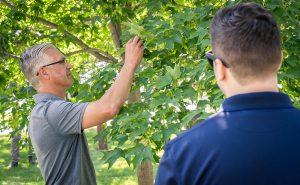Tree Root Care & Enhancement Services in Minnesota
Urban living is tough on trees in the Minneapolis and St. Paul area. Cramped growing spaces, compacted soil, and poor soil nutrition are everyday realities that can harm tree health and may even be fatal. The experts at Rainbow Treecare developed a comprehensive root care service to help damaged trees recover and thrive. Our novel approach to tree root care helps recreate the optimal conditions trees would experience growing in a forest!
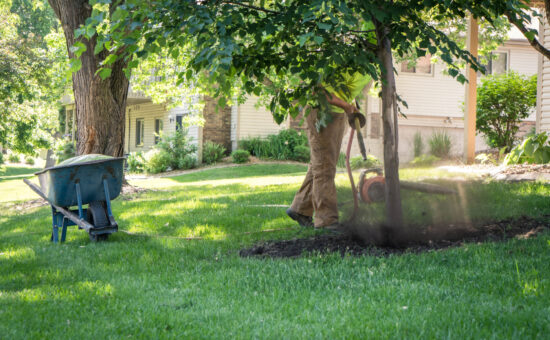
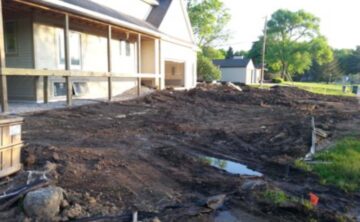
How does our root care service work to restore tree health?
A healthy root system is essential for growing a healthy tree. If roots are damaged, or the soil is compacted, the tree cannot absorb the water and nutrients it needs. Furthermore, once a tree is stressed, it is more vulnerable to additional health risks such as drought, insects, and disease. Rainbow’s holistic root care service works to fluff up the soil and reintroduce vital nutrients. The process also creates the necessary conditions for continued health by reinvigorating the soil so the tree continues to thrive.
When might the root care service be needed?
- Your tree has limited area to grow roots – certain tree species, including maples, are especially vulnerable to girdling roots
- The soil has been compacted, whether due to age, traffic, or construction projects
- Your landscape lacks nutrients
- Trees are struggling to thrive – slow growth, yellowing leaves, dieback, etc.
What can you expect from our root care service?
Step 1: We use a high-powered tool called an air spade to remove existing surface soil, mulch, rock, and landscaping fabric at the base of the tree and expose the structural roots. The high-pressure air is powerful enough to move these materials but will not harm tree roots. We then cut or redirect any roots encircling the tree (girdling roots) to promote proper root development.
Step 2: Roots within a 3-7 foot radius of the tree trunk are exposed, and the soil is amended with highly nutritious organic matter. These soil additives are chosen specifically for your tree.
What is added to the soil?
We incorporate Prescription Organic Matter (POM), a mixture of biologically active organic compounds derived from prescriptive composting processes. High-quality natural nutrients within POM are screened to ensure integrity, consistency, and quality.
Originally created by plants and other organisms, these compounds play key roles in various biological cycles. The nutrients released from these former plants are 100% natural. POM mixtures are available for both fast and slow release of nutrients, and some formulations have a higher nutrient content than others.
Biochar is charcoal made from woody plant material. It is used as a soil amendment to improve soil quality. Charcoal has long been used for its ability to absorb odors and toxins. Adding biochar to soils increases the water retention of sandy soils and improves the porosity of clay soils.
Biochar also helps combat climate change as it converts urban wood waste to a stable form of soil carbon. Additionally, creating healthier growing trees helps sequester additional carbon in the form of woody tree tissue.
Step 3: After the soil has been amended, we install a drip hose around the base of the tree and we cover it with attractive hardwood mulch leaving your landscape looking natural and beautiful. To promote root development, the area must be kept well-watered for the first two weeks following the procedure. We leave a durable “Owl Eye” sprinkler for you to deliberately water a targeted area around your newly treated tree.
Why choose the experts from Rainbow Treecare?
We are Minnesota’s premier licensed and insured tree experts. With over 45 ISA Certified Arborists on staff, we are highly skilled in assessing and performing the services that enhance the health and longevity of your trees. Many factors contribute to a tree’s overall health, including site-specific concerns such as nutrient levels or compacted soil. Our tree experts will address the bigger picture to provide the best treatment outcomes. Additionally, one of our core values is safety. You can rest easy knowing our team will perform all services while taking every precaution to keep our staff, bystanders, and your property safe.
Additional frequently asked questions about root care
Tree roots are often damaged by construction or landscaping projects or by growing in restricted spaces. Over time, regular foot traffic can compact soil, making it difficult for water to penetrate. We might imagine roots growing in a deep, narrow space beneath the tree. But in reality, tree roots extend far beyond the edge of the tree’s canopy, and most roots are found in the upper 6-12 inches of soil.
If roots don’t have enough space to extend out as they grow, they may encircle the tree and “choke” it, a condition called girdling roots. Some symptoms of girdling roots may include abnormally small leaf size, dying branches, and showing early fall color. A tree whose roots have been cut will show signs of poor health on the side that was damaged. Branches may die or fail to leaf out, and existing leaves may wilt and turn brown.
Roots perform vital functions for trees, including stability and anchoring, as well as taking in essential water and nutrients from the soil.
The process re-establishes healthy conditions by de-compacting the soil and reintroducing vital nutrients. Once the roots are exposed, we can also remove or redirect roots that are encircling (girdling) the trunk, thus harming its ability to grow.
Schedule your root care service today!

Four Famous American Trees for the 4th of July
Happy Independence Day! This patriotic holiday is an excellent opportunity to look at some famous American trees. From record holders to historical myths, these trees
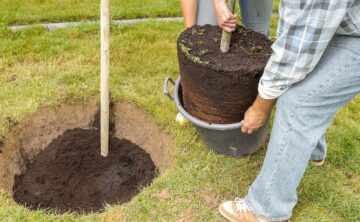
Tree Planting Basics for Minnesota Homeowners
There’s an old saying, “The best time to plant a tree is twenty years ago.” While it makes a humorous point about how long it
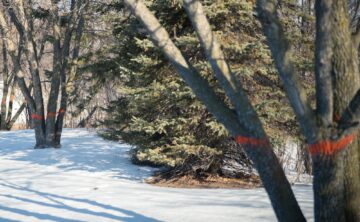
My City Tagged My Tree, Now What?
As Emerald Ash Borer (EAB) continues to impact trees across Minnesota and the Twin Cities metro area, some residents are returning home from work to
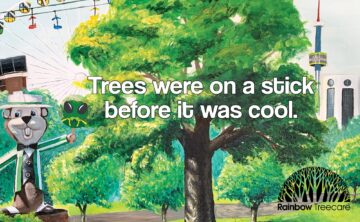
Minnesota State Fair Tree Facts
Trees might not be the first thing you think of when you look back on your visits to the State Fair. For many of us,

